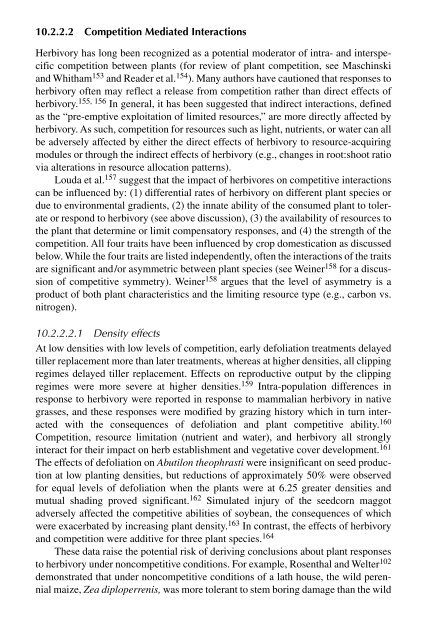Biotic Stress and Yield Loss
Biotic Stress and Yield Loss
Biotic Stress and Yield Loss
- No tags were found...
You also want an ePaper? Increase the reach of your titles
YUMPU automatically turns print PDFs into web optimized ePapers that Google loves.
10.2.2.2 Competition Mediated InteractionsHerbivory has long been recognized as a potential moderator of intra- <strong>and</strong> interspecificcompetition between plants (for review of plant competition, see Maschinski<strong>and</strong> Whitham 153 <strong>and</strong> Reader et al. 154 ). Many authors have cautioned that responses toherbivory often may reflect a release from competition rather than direct effects ofherbivory. 155, 156 In general, it has been suggested that indirect interactions, definedas the “pre-emptive exploitation of limited resources,” are more directly affected byherbivory. As such, competition for resources such as light, nutrients, or water can allbe adversely affected by either the direct effects of herbivory to resource-acquiringmodules or through the indirect effects of herbivory (e.g., changes in root:shoot ratiovia alterations in resource allocation patterns).Louda et al. 157 suggest that the impact of herbivores on competitive interactionscan be influenced by: (1) differential rates of herbivory on different plant species ordue to environmental gradients, (2) the innate ability of the consumed plant to tolerateor respond to herbivory (see above discussion), (3) the availability of resources tothe plant that determine or limit compensatory responses, <strong>and</strong> (4) the strength of thecompetition. All four traits have been influenced by crop domestication as discussedbelow. While the four traits are listed independently, often the interactions of the traitsare significant <strong>and</strong>/or asymmetric between plant species (see Weiner 158 for a discussionof competitive symmetry). Weiner 158 argues that the level of asymmetry is aproduct of both plant characteristics <strong>and</strong> the limiting resource type (e.g., carbon vs.nitrogen).10.2.2.2.1 Density effectsAt low densities with low levels of competition, early defoliation treatments delayedtiller replacement more than later treatments, whereas at higher densities, all clippingregimes delayed tiller replacement. Effects on reproductive output by the clippingregimes were more severe at higher densities. 159 Intra-population differences inresponse to herbivory were reported in response to mammalian herbivory in nativegrasses, <strong>and</strong> these responses were modified by grazing history which in turn interactedwith the consequences of defoliation <strong>and</strong> plant competitive ability. 160Competition, resource limitation (nutrient <strong>and</strong> water), <strong>and</strong> herbivory all stronglyinteract for their impact on herb establishment <strong>and</strong> vegetative cover development. 161The effects of defoliation on Abutilon theophrasti were insignificant on seed productionat low planting densities, but reductions of approximately 50% were observedfor equal levels of defoliation when the plants were at 6.25 greater densities <strong>and</strong>mutual shading proved significant. 162 Simulated injury of the seedcorn maggotadversely affected the competitive abilities of soybean, the consequences of whichwere exacerbated by increasing plant density. 163 In contrast, the effects of herbivory<strong>and</strong> competition were additive for three plant species. 164These data raise the potential risk of deriving conclusions about plant responsesto herbivory under noncompetitive conditions. For example, Rosenthal <strong>and</strong> Welter 102demonstrated that under noncompetitive conditions of a lath house, the wild perennialmaize, Zea diploperrenis, was more tolerant to stem boring damage than the wild

















